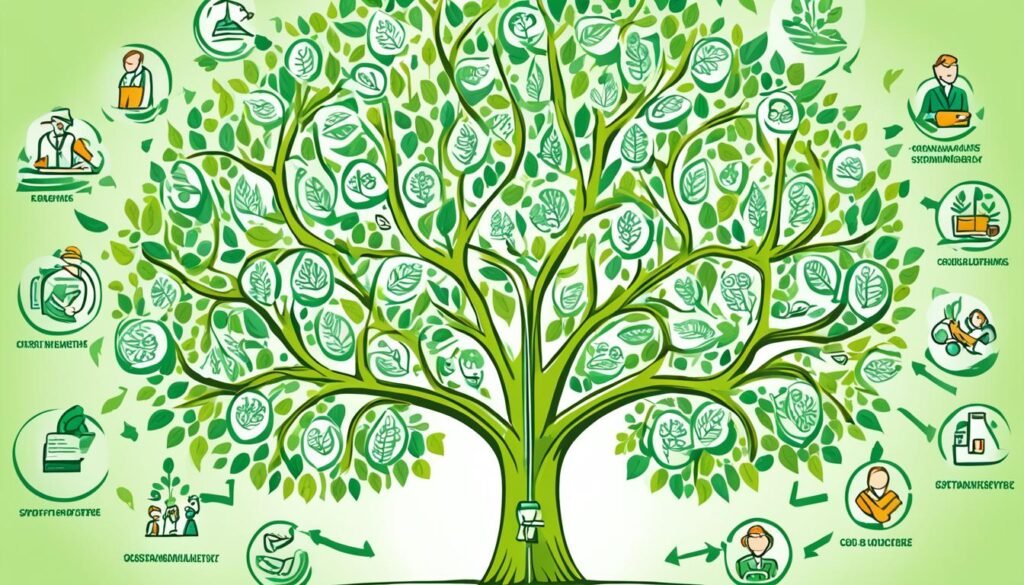Leadership Sustainability: Balancing People and Planet
“The greatest threat to our planet is the belief that someone else will save it.” – Robert Swan
Sustainable leadership is more than just making a profit. It’s finding a balance between people’s needs and our planet’s health. In today’s world, with worries about climate change and hurting nature, leaders must step up. They should take care of their companies and the Earth.
Leaders need to embrace green ways and create a culture for eco-friendly management. This includes making sure employees are healthy and happy. They should think about how their choices affect the environment. Finding new, creative ideas is key to help both people and the planet.
This article will look at the idea of sustainable leadership and its impacts. We’ll focus on the key parts: people, profit, and the planet. Discovering the right strategies can help leaders make a better future that’s strong and green.
Key Takeaways:
- Sustainable leadership seeks to balance the needs of people and the health of the planet.
- Eco-friendly leadership prioritizes the well-being and development of employees.
- Leaders have a responsibility to act as stewards of both their organizations and the Earth.
- Sustainable leadership involves finding innovative solutions that serve both people and planet.
- By embracing sustainable practices, leaders can drive positive change and create a more sustainable future.
Understanding Sustainable Leadership
Sustainable leadership goes beyond just making money. It focuses on creating value for everyone involved, especially the earth itself. This kind of leadership cares about how employees feel and what they do. It encourages a good balance between work and personal life. It’s all about planning for the long term in a way that’s good for people, the planet, and the company’s future.
It’s about leading with a heart for people and the environment. Making money is important, but so is doing right by society and the earth. Leaders in this style look past quick profits. They weave doing good for others and the planet into everything their company does.
Being a good corporate citizen is key. It means doing business in a way that’s fair to all. This includes things like helping out in the community, making sure everyone feels welcome, and keeping the workplace safe.
Running a business without harming the planet matters a lot. This involves using less stuff, saving energy, and making sure the company is kind to the earth. It means using the latest technology to do business without making a mess.
“Sustainable leadership goes beyond profit maximization; it is about creating a legacy of positive impact and responsible organization.” – Roberta Johnson, CEO of GreenTech Solutions
To be a sustainable leader, organizations need to think for the long term. They must build a lasting commitment to being green and socially responsible. This isn’t just about being trendy. It’s a key part of being ready for what’s next.
Here’s a quick look at how some big companies are shining a light on sustainability:
| Company | Sustainable Initiatives |
|---|---|
| Patagonia | Implemented supply chain transparency, adopted regenerative organic agriculture, and committed 1% of sales to environmental organizations. |
| Unilever | Launched the Sustainable Living Plan, aimed at reducing the company’s environmental impact while improving health and livelihoods. |
| Interface | Pioneered sustainable manufacturing processes, aiming to achieve a net-zero environmental footprint by 2020. |
| IBM | Developed its Smarter Planet initiative, focusing on sustainable technologies, infrastructure improvements, and data-driven solutions. |
These examples show why sustainable leadership is important. By being green and caring for society, companies can do well while doing good. This helps them stand out in their fields as ethical leaders.
People: The Heart of the Organization
Prioritizing people leads to sustainable leadership. Leaders who build a positive culture, support growth, and balance work and life create a winning space. This space helps the company and its team grow.
A strong, positive culture is vital for a lasting organization. It brings everyone together, making sure each voice is heard. This not only boosts teamwork but also sparks new ideas.
“A positive workplace culture is essential for sustainable leadership. It fosters collaboration, boosts morale, and enhances productivity. When employees feel valued and supported, they are more likely to invest their skills and talents in achieving the organization’s goals.”
Investing in training and growth is another key. It helps team members to be their best. This push for development isn’t just good for personal growth. It also sparks new ideas that help the company grow too.
Work-life balance is crucial for leaders who want sustainable success. Knowing when to support breaks and time off makes a healthy workplace. This helps team members avoid feeling overwhelmed. It also keeps them happy, making them want to stay with the company.
By focusing on a positive culture, growth opportunities, and balance, leaders can build a strong company culture. This culture helps the company last and succeed.
Benefits of Prioritizing People:
- Improved employee engagement and morale
- Enhanced innovation and creativity
- Higher productivity and performance
- Reduced turnover and increased retention
- Healthy work-life balance for employees
Profit: Driving Sustainable Economic Growth
Profit is key to leading sustainably. Yet, lasting success needs ethics in business and new ideas that care for people and the Earth.
When aiming for growth, long-term plans are vital. It’s necessary to see the future clearly and develop strategies mindful of our planet, society, and financials. With sustainable practices in place, companies can tackle issues and grab chances, all while upholding ethical values.
Being open and fair in business is crucial for lasting growth. It earns trust, shaping a positive image that can boost your company’s worth over time.
“Ethical business practices not only attract customers and investors who align with your values but also contribute to the overall sustainability and success of your organization.”
Today’s business world shifts fast, demanding fresh ideas. Leaders can use technology and new approaches to make their work more efficient, cut down on waste, and find new markets. They might choose to use renewable energy, work on green supply chains, or explore new tech to grow sustainably without harming the planet.
Examples of Ethical Business Practices
| Ethical Business Practice | Potential Benefits |
|---|---|
| Fair labor practices | Improved employee satisfaction and retention |
| Sustainable sourcing | Enhanced reputation and consumer trust |
| Transparency in financial reporting | Increased investor confidence |
| Community engagement | Positive impact on local communities |
In summary, sustainable growth calls for planning, ethics, and new ideas. With these as the foundation, leaders can make a real difference for the planet and society, all while ensuring their business’s future success and profits. Profit and sustainability don’t have to be at odds, but work together with ethical leadership.
Planet: A Commitment to Environmental Stewardship
We lead as stewards, focusing on the care of our planet. Our aim is to lessen our impact by implementing green policies. These policies not only cut down negative effects but boost sustainability and social responsibility too.
To reduce our impact, we cut down on waste. We use smart waste management. This means we use recycling and composting a lot. It helps keep trash out of landfills.
Reducing our carbon footprint fights climate change. We focus on using energy better and turning to green power sources. This way, we use less fossil fuel, helping the planet in the long run.
Making our entire supply chain green is also key. We choose suppliers who care about the earth like we do. This means picking good materials and cutting down on greenhouse gas from transport.
Getting involved in social responsibility shows our care. We support projects that help the planet and people. By working closely with communities, we build strong bonds. This helps us all grow and prosper together.
Our role in protecting the planet is vital for the future. By acting now, we help shape a world that’s sustainable and strong. This involves using green ways, supporting sustainability, and being socially responsible.
“The Earth is what we all have in common.” – Wendell Berry
| Ways to Reduce Environmental Impact | Benefits |
|---|---|
| Minimize waste | – Reduces landfill usage – Conserves resources – Supports the circular economy |
| Reduce carbon footprint | – Mitigates climate change – Promotes energy efficiency – Fosters sustainability |
| Promote sustainability in the supply chain | – Ensures ethical practices – Reduces environmental footprint – Enhances brand reputation |
| Engage in CSR initiatives | – Creates a positive impact on society – Fosters stakeholder trust – Drives sustainable development |
The Path Forward
Sustainable leadership is key for future successes in business. Leaders today need to see the big picture. They must understand how their choices affect society and the planet.
This kind of leadership looks past quick benefits. It works on long-lasting and ethical business models. These models put people and the Earth first. Leaders do this by making choices that help both their business and the world.
Choosing sustainable leadership benefits everyone. It’s a wise business move that also helps the planet. Leaders think about the future when making decisions. They aim for approaches that are good for business, people, and nature.
Businesses can help make a world where doing well means doing good for people and the Earth. They lead by using sustainable practices themselves. This shows others a positive way forward.
“Sustainable leadership involves recognizing that the health and success of a business are intertwined with the well-being of people and the environment.”
Putting sustainable leadership first leads to lasting success. It brings in top workers and support from investors. People want to be part of companies with a strong, ethical goal.
Sustainable Leadership in Action
Patagonia is a prime example of this type of leadership. They’re known for caring about the environment. Their Worn Wear program helps reduce waste by fixing and selling used clothes.
Interface is another standout. They set high goals for being good to the Earth. They understand how their choices affect the planet. This inspires them to always look for ways to do better.
“Sustainable leadership not only benefits the environment but also drives innovation and enhances reputation.”
Choosing sustainable practices opens up new chances for growth and teamwork. It helps create a world that’s fairer and lasts longer. This is key for a business’s own success in the long term.
Creating a Sustainable Leadership Culture
Building a culture of sustainable leadership takes many steps. It means making everyone feel connected. This happens through talking openly and working together at every level.
This culture cares about its people and their growth. It lets employees help meet green goals. Supporting a good work-life balance keeps the team strong and motivated.
It’s important for this culture to reach outside the company, too. Businesses should talk to all the groups involved. This helps build trust and find common goals. Working together makes everyone stronger.
In the end, sustainable leadership is all about teamwork. It’s about seeing how what we do affects each other and the world. By choosing to do good, leaders can make a lasting, fair, and successful business world for us all.
Align with Standards and Frameworks
It’s key for companies to balance people, planet, and profit in sustainability reports by using global standards. This ensures reports are correct and believable. It also helps share info in a way everyone can understand. This makes comparing how well companies are doing in sustainability easier.
The Global Reporting Initiative (GRI)
The GRI is a well-known framework for sustainability reports. It gives out detailed guidelines and metrics for measuring and sharing how a company affects the economy, environment, and society. Using GRI standards makes companies’ reports clear and easy to compare for stakeholders.
The Sustainability Accounting Standards Board (SASB)
The SASB gives standards by industry for reporting on sustainability. These help companies talk about the important financial parts of their impact on the environment and society. Following SASB’s guidance means companies are talking about the sustainability parts that actually matter to investors and other people interested in the company.
The International Integrated Reporting Council (IIRC)
The IIRC pushes for reports that combine financial and other important kinds of info. This gives a complete look at how a company creates value. Talking about value creation in this wider way helps companies show how they plan to do well over time using many types of resources.
Task Force on Climate-related Financial Disclosures (TCFD)
The TCFD shares how companies should talk about financial risks and opportunities from climate change. They help businesses look at and talk about the risks of a changing climate, like physical damage or costs from laws. Companies can show how they plan to deal with these risks by following TCFD’s advice in their reports.
Using global standards helps make sustainability reporting more honest and clear. It lets companies share how well they’re doing in ways everyone can understand. Following these rules helps make the business world work better for the planet and people.
| Standards and Frameworks | Description |
|---|---|
| Global Reporting Initiative (GRI) | A comprehensive framework for sustainability reporting that provides guidelines and metrics to measure and disclose economic, environmental, and social impacts. |
| Sustainability Accounting Standards Board (SASB) | An organization that develops industry-specific standards for reporting financially material sustainability risks and opportunities. |
| International Integrated Reporting Council (IIRC) | An organization that promotes integrated reporting, combining financial and non-financial information to provide a holistic view of an organization’s value creation. |
| Task Force on Climate-related Financial Disclosures (TCFD) | A task force that provides guidance on disclosing climate-related financial risks and opportunities, helping organizations assess and report their exposure to climate-related risks. |

Engage with Stakeholders
In sustainability reports, talking to stakeholders is key for trust and openness. Organizations learn what their stakeholders wish for. They also understand what issues matter most to them. This helps in making better sustainability plans.
Stakeholders include customers, staff, investors, and local groups. They all have different views. Listening to them ensures reports cover everyone’s concerns. It also helps to create projects that meet the stakeholders’ needs.
Open and fair listening helps build a solid bond between the organization and its stakeholders. It shows a dedication to working together. This trust is the base for lasting partnerships. It helps solve problems before they get big.
By talking to stakeholders, organizations show they care. They act with stakeholder thoughts in mind. This proves they want to do right by the community, environment, and economy. It’s about acting responsibly and making the right choices.
“Stakeholder engagement is a cornerstone of sustainability reporting, allowing organizations to understand diverse perspectives and make informed decisions. It fosters collaboration, builds trust, and enables organizations to take actions that create shared value for all stakeholders.”
Prioritizing Stakeholder Engagement
Companies can put stakeholder talks first by:
- Keeping close to stakeholders for their views and to solve problems.
- Asking for feedback on green goals and performance.
- Including stakeholders in choosing sustainability steps.
- Setting up ways to always talk to stakeholders.
Doing these things helps organizations connect better with their stakeholders. It helps get advice for improvement. And it makes sure that their green efforts match the community’s wishes and values.
Case Study: Company X’s Stakeholder Engagement
| Stakeholder Group | Engagement Approach | Outcomes and Benefits |
|---|---|---|
| Customers | Holding regular focus groups and surveys to understand customer expectations and preferences | Improved product design and development to meet customer requirements |
| Employees | Conducting regular feedback sessions, town halls, and surveys to address employee concerns and foster a positive work environment | Enhanced employee satisfaction, increased productivity, and reduced turnover |
| Investors | Engaging with investors through annual sustainability reports and dedicated investor conferences to provide transparency and address ESG concerns | Enhanced investor confidence and improved access to capital |
| Communities | Organizing community forums and outreach programs to understand community needs and address social impact | Stronger community partnerships, increased social license to operate, and positive social outcomes |
Company X has improved its environmental record through close talks with stakeholders. This team effort has achieved big results. It has strengthened the company and benefitted all involved.
Conclusion
Sustainable leadership is crucial for finding a balance among people’s needs, making profit, and protecting the planet. It focuses on keeping employees happy, doing business fairly, and caring for the environment.
Being truthful and clear in sustainability reports is very important in sustainable leadership. It helps avoid the misleading tactic of greenwashing. When leaders act with honesty and make decisions with integrity, they build trust and are seen as responsible leaders.
Choosing sustainable leadership means committing to a brighter future. It’s about understanding the link between helping people, growing businesses, and saving the Earth. Leaders achieve this by using sustainable approaches and making smart choices. They lead their companies to a greener future, benefiting society and the environment for many years.
FAQ
What is sustainable leadership?
Sustainable leadership aims to fulfill the needs of people, profits, and the planet. It looks to add value long-term for the business, its workers, the community, and nature.
What does sustainable leadership prioritize?
It focuses on growing employees, building a healthy work environment, and practicing business in a sustainable way. This includes taking care of the earth.
Why is the development of employees important in sustainable leadership?
Working on employees’ growth brings new ideas and more work done. It also makes the workplace a better place and helps with balancing work and personal life.
How does sustainable leadership achieve financial success?
It reaches financial goals by planning for the long haul and doing business right. This means using new tech to be more effective and finding new ways to sell.
How does sustainable leadership promote environmental responsibility?
It cuts down on how much harm business does to the earth. This includes using less, making less waste, and thinking green from start to finish.
Why is sustainable leadership important in a globalized world?
In the world we live in today, it’s key to lead with the future in mind. Leaders need to see how their choices affect everyone and everything.
What are some internationally recognized standards and frameworks for sustainability reporting?
Top ways to talk about being green include the Global Reporting Initiative (GRI) and others like the Sustainability Accounting Standards Board (SASB). They help share info on social, environmental, and financial stuff.
Why is stakeholder engagement important in sustainability reporting?
Listening to stakeholders focuses on the right topics, builds trust, and shows how a company adds value to those it works with.
Why is avoiding greenwashing important in sustainable leadership?
Misleading about being eco-friendly hurts the real meaning of good leadership. Transparent reporting on going green makes leaders show they’re truly responsible.
Source Links
- https://www.linkedin.com/pulse/sustainable-leadership-balancing-people-profit-planet-eva-jenkins-dh03e?trk=article-ssr-frontend-pulse_more-articles_related-content-card
- https://www.responsiblebusiness2030.com/its-all-about-the-culture/balancing-people-planet-and-profit/
- https://www.linkedin.com/advice/3/what-best-practices-balancing-people-planet-profit-75cef








